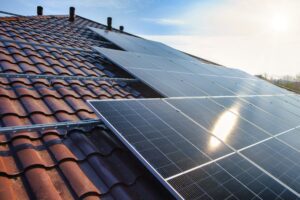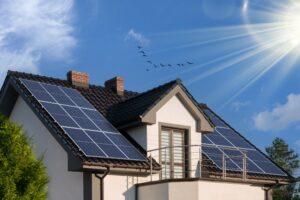Rooftop solar panels have become a common sight, with more than a million installations across the UK. They offer householders key advantages including free, renewable energy, reduced electricity bills and a smaller carbon footprint.
There is, however, also a different solar option you may not be aware of – solar roof tiles – also called solar roof slates or solar panel roof tiles, which are a relatively new green energy solution. They’re gaining momentum as a feasible, more aesthetically appealing alternative to solar panels in the UK thanks to big names such as Tesla solar roof tiles, GB Sol solar slate tiles, and Solecco solar tiles paving the way for this solar innovation.
Solar tiles aren’t widely manufactured and aren’t as easily available as solar roofing solutions in the UK as yet, but are attracting growing interest from manufacturers and customers alike.
In this guide, you can discover how solar tiles work, their pros and cons, and how much they are likely to cost.
What Are Solar Roof Tiles?
Solar roof tiles look like conventional roof tiles and perform the same weatherproofing function in protecting houses from the elements, but they also generate solar electricity for the home.
A solar roof tile is a type of building-integrated photovoltaic system, and more and more new homes are being built with solar-tiled roofs as standard. Like traditional solar panels, solar slates use photovoltaic (PV) technology to generate energy from the sun and convert this into usable electricity to power homes.
New-build houses could one day opt for a solar roof tile system as standard roofing. This prevents the need for installing solar panels at a later date, and a solar panel roof tile still achieves all the same things. Yet unlike traditional solar panels, they aren’t as bulky or obvious, which could be more attractive to the modern homeowner.
Photovoltaics
Photovoltaic technology provides a sustainable alternative to fossil fuels and has transformed how energy is produced and used.
- A semiconductor solar cell such as silicon triggers the photovoltaic response – a phenomenon in physics and chemistry.
- Photons in sunlight react with electrons in the solar cell to create an electrical field that generates a direct current (DC).
- A solar inverter turns this DC electricity into an alternating current (AC) so it can power homes and electrical appliances.
Although solar panels and solar roof tiles use the same photovoltaic technology, there’s a big difference between how the two systems are installed.
- Create a Tailored Quote Based On Your Circumstances
- Takes Less Than 2 Minutes
- Fixed-Online Quotes

Solar Panel Roof Tiles Installation
Installing standard rooftop solar panels usually takes around two days. Replacing roofing tiles with solar tiles should take about a week.
Solar panels are mounted on top of roof tiles or slates, bolted on with mounts and clamps. The number of panels varies from house to house.
But solar panels aren’t designed to cover the entire roof. Although this would maximise power output, it’s not a feasible solution and could cause structural issues to a roof.
Solar roof tiles, on the other hand, provide a completely new, external solar roof. This type of sustainable architecture provides electrical power while the solar tiles also protect properties from wind, rain, snow, and sun.
Types of Solar Roof Tiles
Like solar panels, solar roof tiles contain semiconducting, photovoltaic solar cells that convert sunlight into an electric current.
Solar panels can be made from monocrystalline solar cells, polycrystalline solar cells, or thin-film solar cells. However, polycrystalline cells aren’t used in solar tiles because the technology needs to be more compact.
Monocrystalline Solar Roof Panels
Monocrystalline solar cells – single crystals of pure refined silicon – soak up more sunlight than thin-film solar cells. This results in better performance. Mono solar cells have an efficiency rating of 15-25%.
Silicon is a widely-available material. However, the monocrystalline solar cell manufacturing process creates silicon wastage that can’t be reused for other monocrystalline solar roof panels, which more eco-conscious homeowners might find difficult to contend with.
Monocrystalline solar cells are more expensive than thin-film PV tiles but generally last longer.
Thin-Film Solar Roof Panels
A type of second-generation solar technology, thin-film PV roof tiles comprise layers of semiconducting materials on a substrate such as glass or plastic. They’re typically less efficient than monocrystalline solar cells but cost less, and the tiles are lighter and more flexible.
Thin-film solar roof tiles are easy to manufacture, require less material, and generate less waste. They’re currently less efficient than monocrystalline solar cells, with lower power capacities, but they’re more resistant to high temperatures, and the performance of thin-film PV cells is expected to improve in the future.
How Energy Efficient Are Solar Roof Tiles?
Energy efficiency – eliminating energy waste – is a pivotal measure in the drive towards net zero carbon emissions by 2050. Besides reducing carbon emissions, solar technology cuts household electricity costs significantly.
Generally, the greater a solar energy system’s efficiency, the more electricity it is able to produce with a given level of daylight. Good levels of electricity production reduces dependence on the national grid and saves money on energy bills.
Most solar panels convert around 15-22% of sunlight into usable energy. Solar roof tiles are generally around 10-20% energy efficient.
However, the technology behind solar panels has been around a lot longer than solar tiles, so it’s very likely that the energy efficiency levels will improve with occasional updates as the technology advances.
Advantages of Solar Roof Tiles
Photovoltaic roof tiles are sleek and stylish and incorporate solar technology into a building by blending seamlessly with the architectural design, all without disrupting the appearance of the roofline. Although lightweight, they’re designed to be stronger, more durable, and more weather resistant than standard roof tiling.
A solar slate roof increases energy independence, which cuts electricity bills and contributes to the move towards net zero. A further advantage of solar roof tiles is that for most people they will add value to a property, with green energy installations appealing to potential buyers.
PV slates and solar shingles may provide a solution in conservation areas and for listed buildings in particular where regular solar panels are often not an option. Solar panels here could contravene planning regulations because of the perceived negative aesthetic impact of the panels clearly visible on the roof surface. Solar roof tiles UK solve this issue.
Disadvantages of Solar Roof Tiles
The aesthetic appeal of a solar roof comes at a price. PV tiles are less energy efficient than conventional solar panels, so you need more of them to generate the same amount of power. This is one of the reasons the entire roof needs to be replaced when installing solar roof tiles – a few simply won’t cut it.
Because this is a much bigger job than fitting solar panels and takes a lot longer, solar roof tiles cost twice as much as solar panels or even more in some cases depending on your roof space and the tiles you’re replacing.
A further drawback with solar tiles is that they’re not suitable for some homes because of the incline and angle of the roof. Unlike solar panels, solar tiles can’t be angled and adjusted, so a proper installation at an angle that suits is necessary from the start.
- Create a Tailored Quote Based On Your Circumstances
- Takes Less Than 2 Minutes
- Fixed-Online Quotes

Solar Panels Vs Solar Roof Tiles
Solar panels, installed on top of roof tiles or slates, are an established green energy solution in the UK. Solar roof tiles are like mini solar panels but are a relatively new green energy solution and they can only be installed as an entire solar roof to replace an existing roof, or when building a new home.
As we’ve seen, solar roof tiles are less efficient than solar panels. But what other differences exist between the two types?
The Aesthetic Debate
Solar panels divide opinion aesthetically, and the debate is subjective. Some people like the look of solar panels on a roof. Some think they’re an eyesore, while others are indifferent.
If you’re less than impressed with the visual impact of solar PV panels, solar roof tiles may be the perfect solution and something to consider for the future.
The bulkier design of solar panels means they project out from the roof, and they’re usually coloured black or blue. Solar tiles, on the other hand, replicate the appearance and colour of standard roofing tiles.
Durability
Solar panels can last 20 to 25 years. Solar tiles haven’t been around long enough for us to know their true expected lifespan. However, they’re designed to withstand the elements and will protect a property the same as a standard roof while providing free electricity.
Maintenance
With solar panels, there’s a gap between the panels and the roof. Debris can collect in this space, as can rainwater or snow. Birds and other small animals may also make their home there, meaning that they are unable to operate at optimal efficiency.
But solar roof tiles don’t have these problems. Solar tiles aren’t just part of a roof, they form the entire roof, which makes them low maintenance, too. All you need to do is hose the roof down periodically with warm water.
Availability
Unlike solar panels, availability of PV roof tiles in the UK is limited at the moment. Only a few companies currently make solar tiles, the main ones being Solecco Solar in England and GB-Sol Solar tiles in Wales.
The most widely recognised global solar tile brand is the Tesla Solar Glass Roof, and the company accepts online orders from around the world.
Solar Panels Cost Vs Solar Roof Tiles Cost
Are solar roof tiles worth it? The price of both solar panels and solar roof tiles continues to fall, but solar panels cost a lot less. One of the main reasons for this is because installation of solar roof tiles is more complex, entailing a total roof replacement. Plus, PV tile technology is newer, with a less competitive market.
As a rough guide, solar tiles are at least twice the price of solar panels.
For an average home (requiring 3KW of solar power), a solar roof could cost £10,000 to £15,000. Fitting solar panels to the roof would cost just over £6,000.
Because solar tiles are less efficient, it would take longer before energy savings see a return on investment. However, if your roof needs replacing anyway, the cost of a solar roof could be similar to that of a conventional roof, with the added benefits of a solar energy system and a potentially stronger and more weather-resistant structure.
According to the Energy Saving Trust, a solar roof could increase the value of your home by as much as 10% – a significant payback if you decide to sell your house in the future.
What’s the Difference Between Solar Roof Tiles and Integrated Solar Panels?
Solar roof tiles are often mistakenly described as integrated solar panels. Unlike solar tiles, integrated solar panels aren’t designed to look like roof tiles or slates and typically don’t cover the entire roof.
The installation process is completely different too. With integrated solar panels, there’s no need in most cases to modify the underlying structure of the roof. The panels are fixed into the roof itself, sitting flush with surrounding standard tiles.
Are Solar Roof Tiles Right for Your Home?
Solar roof tiles are a state-of-the-art renewable energy solution that combines the ecological credentials of solar panels with a subtle, elegant aesthetic design. They’re becoming more popular in the US as an alternative to solar panels, and the UK looks set to go the same way.
While they may not be suitable for every home, they offer a green energy option for householders planning a new roof who want it to be visually appealing while also incorporating solar technology. A solar roof could also be suitable for a listed building or a home in a conservation area.
At the moment, though, solar panels provide the best cost-effective option for most householders looking to cut electricity bills and reduce their carbon footprint. Contact us if you are considering a solar project for your home or business.
- Create a Tailored Quote Based On Your Circumstances
- Takes Less Than 2 Minutes
- Fixed-Online Quotes




